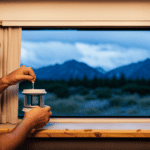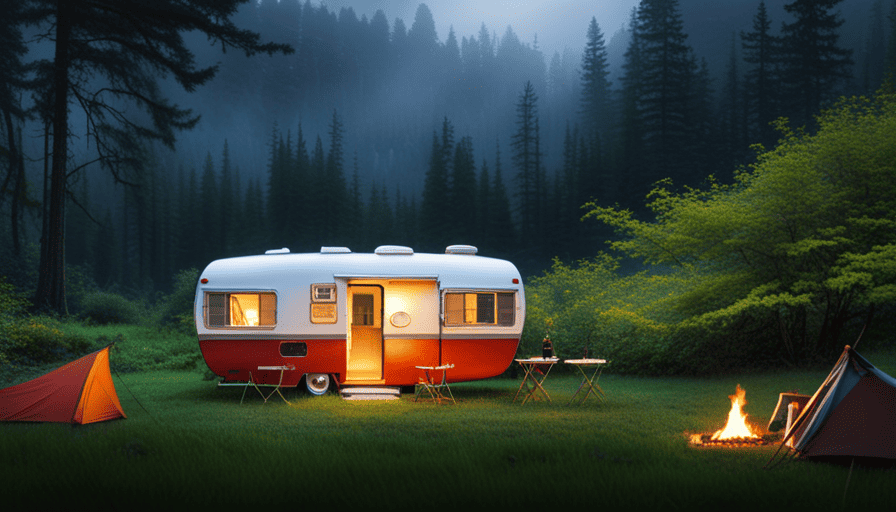Picture this: it’s a crisp autumn morning, the sun rising over the horizon as you sit comfortably inside your pop-up camper, savoring a piping hot cup of coffee. Even though it’s chilly outside, your camper is keeping you nice and warm. You may be curious, how did you achieve such a high level of comfort while camping? The answer is simple: proper insulation.
Insulating your pop up camper is the key to creating a comfortable and inviting space, no matter the season or weather conditions. In this article, I will guide you through the process of insulating your pop up camper from start to finish.
From assessing your camper’s current insulation to choosing the right materials and installing them in your walls, ceiling, windows, doors, and flooring, I will share my knowledge and experience to help you create the perfect insulation for your camper.
So let’s dive in and transform your pop up camper into a haven of warmth and comfort for your next outdoor adventure.
Key Takeaways
- Proper insulation is crucial for creating a comfortable and inviting space in a pop-up camper.
- Assess the current insulation for wear, damage, and air leaks to ensure efficiency.
- Choose the right insulation materials such as foam or fiberglass, considering factors like thermal resistance and ease of installation.
- Insulate the walls, ceiling, windows, doors, and flooring of the camper to prevent drafts, heat loss, and noise.
Assess Your Camper’s Current Insulation
Now, let’s take a moment to assess your camper’s current insulation so you can start enjoying cozy nights under the stars!
Evaluating the insulation effectiveness is crucial to determine if improvements are needed. Begin by examining the walls, floor, and ceiling for any signs of wear or damage that may compromise insulation efficiency. Look for gaps, cracks, or holes where cold air can seep in and warm air can escape. Pay close attention to the corners and edges, as these are common areas for air leaks.
Next, feel the temperature inside the camper during different weather conditions. If you notice significant temperature fluctuations or drafts, it’s a clear indication that the insulation isn’t performing optimally. Additionally, check the insulation thickness. The thicker the insulation, the better it’ll be at keeping your camper comfortable.
Consider the age of your camper as well. Older models may have outdated or worn-out insulation, which can lead to poor insulation efficiency. In such cases, it may be necessary to replace the insulation entirely.
By evaluating your camper’s current insulation, you can identify areas that require improvement. Once you have a clear understanding of your insulation needs, you can move on to choosing the right insulation materials that’ll provide maximum comfort and energy efficiency.
Choose the Right Insulation Materials
When considering insulation materials for my pop-up camper, I’ve found that there are various types to choose from. Some options include foam and fiberglass. Each type has its own benefits and drawbacks, so it’s important to carefully evaluate which one would be most suitable for my camper’s structure.
Based on my experience, I’ve learned that selecting the right insulation materials is crucial. Proper insulation is essential for maintaining a comfortable interior temperature in my camper.
Consider insulation types (e.g., foam, fiberglass)
First, you’ll want to explore different insulation types, such as foam or fiberglass, to ensure your pop-up camper stays cozy in any weather condition. When comparing insulation options, consider factors like R-value, ease of installation, and durability.
Here are three key points to consider:
-
Foam insulation: This type of insulation offers excellent thermal resistance and is easy to install. It can be sprayed or applied in rigid panels, providing a seamless barrier against heat transfer.
-
Fiberglass insulation: Fiberglass is a popular choice due to its affordability and availability. It comes in rolls or batts and can be easily cut and fitted into spaces. However, it may not provide as high of an R-value compared to foam insulation.
-
Installation process: Both foam and fiberglass insulation require careful installation to ensure maximum effectiveness. Properly sealing all gaps and seams is crucial to prevent air leaks and maintain insulation efficiency.
Now that you have an understanding of insulation types, it’s time to select materials suitable for your camper’s structure.
Select materials suitable for your camper’s structure
To ensure your cozy home away from home, you’ll need to carefully select materials that perfectly suit your camper’s structure. When it comes to insulating a pop-up camper, selecting appropriate materials is crucial for optimal comfort and efficiency.
One of the most popular choices is foam insulation, which provides excellent thermal resistance and is easy to install. Fiberglass insulation is another option that offers good insulation properties and is resistant to moisture.
When choosing insulation materials, consider the weight and thickness to ensure they are suitable for your camper’s structure. Additionally, think about the installation techniques that will work best for your camper, such as adhesive or stapling.
By selecting the right materials and installation techniques, you can effectively insulate your pop-up camper and create a cozy living space.
Now, let’s move on to the next section and prepare your camper for insulation.
Prepare Your Camper
Before starting the insulation process, it’s essential to thoroughly clean and clear the interior of the camper. This includes removing any dirt, debris, or personal belongings that may be in the way.
Additionally, if there’s already existing insulation in the camper, it’s necessary to remove it before proceeding with the new insulation. By following these steps, you can ensure a clean and blank canvas for the insulation project, allowing for optimal results.
Clean and clear the interior
Once you’ve tidied up the inside of your pop-up camper, you’ll create a cozy and inviting space for your camping adventures. Here are four essential steps to help you with interior cleaning and organizing space:
-
Start by removing any loose items and debris from the camper. Sweep or vacuum the floors to ensure a clean base.
-
Wipe down all surfaces, including countertops, tables, and cabinets, with a mild cleaning solution. Don’t forget to clean the windows and mirrors for a clear view.
-
Organize your belongings by using storage bins and organizers. Maximize the available space by utilizing vertical storage options and keeping similar items together.
-
Consider adding hooks or hanging storage solutions to make use of unused wall space. This will help keep items off the floor and create a more organized environment.
Once you’ve cleaned and organized the interior, you can move on to removing any existing insulation if necessary.
Remove any existing insulation if necessary
First, check the condition of the insulation inside your camper to determine if it needs to be removed. Assessing the insulation’s effectiveness is crucial to ensure proper insulation in your pop-up camper. Start by examining the insulation for any signs of damage, such as mold, mildew, or water stains. If you notice any of these issues, it’s best to remove the old insulation and start fresh.
Removing the existing insulation can be a time-consuming process, but it’s necessary for effective insulation. Use a utility knife or scraper to carefully peel away the old insulation from the walls and ceiling of your camper.
Once the old insulation is removed, you can move on to the next step of installing new insulation in the walls and ceiling, which will be discussed in the subsequent section.
Install Insulation in Walls and Ceiling
To start insulating your pop-up camper, you’re gonna wanna carefully measure and cut the insulation panels. Make sure to cover every inch of the walls and ceiling to keep that cozy warmth inside, like wrapping your camper in a giant, insulating hug.
When it comes to choosing the right insulation material, there are a few options to consider. Fiberglass insulation is a popular choice due to its affordability and effectiveness in reducing heat transfer. Another option is foam insulation, which provides excellent insulation properties and can be easily cut and fitted into the walls and ceiling of your camper.
Once you’ve chosen your insulation material, it’s time to start the installation process. Begin by cleaning the walls and ceiling thoroughly to ensure a smooth surface for the insulation to adhere to. Next, cut the insulation panels to fit the dimensions of your camper’s walls and ceiling, making sure to leave a small gap around windows and doors for future installation. Secure the insulation panels using adhesive or staples, ensuring a tight fit.
Now that the walls and ceiling are insulated, it’s time to move on to the next step and insulate the windows and doors. This will help further prevent any drafts or heat loss.
Insulate Windows and Doors
Now, let’s cozy up your little home on wheels by making sure those windows and doors are nice and snug, keeping the chilly air out and the warm vibes in.
When it comes to insulating windows in your pop-up camper, there are a few simple and effective methods you can try.
First, consider using thermal curtains or blinds. They’re designed to block out drafts and keep the cold air from seeping in through the windows. They also provide an extra layer of insulation, helping to maintain a comfortable temperature inside your camper.
Another option is to apply window insulation film. It’s transparent and easy to install, forming a barrier against drafts. It works by trapping a layer of air between the film and the window, providing additional insulation.
Lastly, you can use weatherstripping tape to seal any gaps around the edges of your windows. The tape is adhesive and can be easily applied to create a tight seal. It helps prevent drafts and keeps the warm air inside.
When it comes to securing doors, weatherstripping is also a great option. Apply weatherstripping tape around the edges of the door to create a tight seal. Additionally, make sure the door is properly aligned and closes tightly.
Now that your windows and doors are nice and snug, let’s move on to the next step: sealing gaps and cracks.
Seal Gaps and Cracks
Ready to make your cozy home on wheels even cozier? Let’s tackle those pesky gaps and cracks that let in the cold air and disrupt your warm vibes. To effectively seal these openings, you’ll need to use the right sealants and weatherstripping materials.
Sealants are great for filling larger gaps and cracks in your pop-up camper. Look for a high-quality sealant that is specifically designed for outdoor use and can withstand changing temperatures. Apply the sealant along the edges of windows, doors, and any other areas where you notice drafts or gaps. Be sure to follow the manufacturer’s instructions for application and drying time.
In addition to sealants, weatherstripping is essential for sealing smaller gaps and preventing air leakage. Weatherstripping comes in various forms, such as adhesive strips or foam tapes. Measure the gaps and cracks carefully and cut the weatherstripping to fit. Apply it along the edges of windows and doors, ensuring a tight seal when closed.
To help visualize the effectiveness of sealing gaps and cracks, here’s a table showcasing the difference it can make:
| Before Sealing | After Sealing |
|---|---|
| Cold drafts | Cozy warmth |
| Air leakage | Energy savings |
| Disrupted vibes | Comfort and peace |
With the gaps and cracks sealed, your pop-up camper will be better insulated, keeping you warm and cozy. Now, let’s move on to insulating the flooring for even more comfort.
Insulate Flooring
Get ready to take your cozy home on wheels to the next level by insulating the flooring, making it even more comfortable for you.
Insulating the flooring of your pop-up camper is an essential step in creating a more energy-efficient and comfortable living space. Not only does insulation help to keep the cold air out during winter and the hot air out during summer, but it also helps to reduce noise and vibrations from the road.
To insulate the flooring, start by removing the existing flooring material. This will give you access to the subfloor, which is where the insulation will be placed. Use a high-quality insulation material, such as foam board or fiberglass batts, to insulate the subfloor. Cut the insulation to fit the dimensions of your camper and secure it in place using adhesive or nails.
In addition to insulating the flooring, don’t forget to insulate the walls and roof of your pop-up camper as well. This will help to create a more comfortable and energy-efficient living space.
Once the flooring, walls, and roof are properly insulated, you can move on to the next step: installing reflective insulation. This will further enhance the insulation properties of your pop-up camper and make it even more comfortable for your adventures.
Install Reflective Insulation
To take your cozy home on wheels to the next level, enhance the comfort and energy efficiency by installing reflective insulation, like a shield of warmth and protection for your adventures. Installing reflective insulation in your pop-up camper has numerous benefits.
Firstly, it helps to regulate the temperature inside, keeping it cool in the summer and warm in the winter. This is achieved by reflecting the sun’s rays during hot days and preventing heat loss during cold nights.
Secondly, reflective insulation also acts as a sound barrier, reducing outside noise and creating a more peaceful environment inside your camper.
When installing reflective insulation, there are a few steps to follow. First, measure the dimensions of your camper’s walls and ceiling to determine the amount of insulation needed. Next, cut the reflective insulation to fit these measurements, leaving a small overlap to ensure complete coverage. Then, simply attach the insulation to the walls and ceiling using adhesive or staples, making sure to smooth out any wrinkles or air pockets. Finally, seal any gaps or seams with reflective tape to maximize the insulation’s effectiveness.
By installing reflective insulation, you’ll enjoy a comfortable and energy-efficient space inside your pop-up camper, regardless of the weather conditions outside.
In the next section, we’ll discuss how to test and adjust the insulation to ensure optimal performance.
Test and Adjust Insulation
When testing and adjusting the insulation in my pop-up camper, I make sure to monitor the temperature inside the camper regularly. This helps me determine if the insulation is effectively keeping the interior temperature stable.
If I notice any fluctuations or inconsistencies, I make adjustments as necessary, such as adding additional layers of insulation or sealing any potential air leaks. With my experience, I’ve learned that regularly testing and adjusting the insulation ensures maximum comfort and efficiency while camping.
Monitor temperature inside the camper
Although it’s essential to keep track of the temperature inside the camper, there are various methods to effectively monitor it. To ensure optimal comfort and efficiency, it’s crucial to invest in reliable monitoring devices. These devices can provide real-time temperature readings and alert you to any fluctuations.
Additionally, implementing temperature control strategies can help maintain a consistent and comfortable environment. Here are three sub-lists to help you enjoy what’s written:
-
Use a digital thermometer: This handy device provides accurate temperature readings and allows you to monitor changes easily.
-
Install a thermostat: A programmable thermostat enables you to set specific temperature ranges and adjust them as needed.
-
Consider a temperature monitoring system: These advanced systems offer remote access and notifications, allowing you to monitor the camper’s temperature from anywhere.
By closely monitoring the temperature inside the camper, you can identify any issues promptly and make adjustments as necessary to ensure a comfortable and enjoyable camping experience.
Make adjustments as necessary
One effective way to maintain a comfortable temperature inside the camper is by regularly adjusting the temperature control settings. This allows you to make modifications and adjust accordingly based on the outside temperature and personal preferences. By understanding the temperature control system and making necessary adjustments, you can create a cozy and inviting atmosphere inside your camper. To help you better visualize the process, here’s a table outlining the recommended temperature settings for different weather conditions:
| Weather Condition | Recommended Temperature |
|---|---|
| Hot and Humid | 75-80°F |
| Mild | 68-72°F |
| Cold | 60-65°F |
| Freezing | 50-55°F |
By following these guidelines and making adjustments as necessary, you can ensure a comfortable and enjoyable camping experience. Now, let’s move on to the next section and learn how to fully enjoy your cozy camping experience.
Enjoy Your Cozy Camping Experience
Make sure you create a cozy camping experience by insulating your pop-up camper properly. Insulation plays a crucial role in keeping you warm during chilly nights and cool during hot summer days. To achieve the ultimate coziness, here are four essential steps to follow:
-
Choose the right insulation materials: Opt for materials that’re lightweight, durable, and have excellent insulating properties. Foam boards, reflective insulation, and spray foam are popular choices for pop-up campers.
-
Insulate the walls and ceiling: Start by measuring the dimensions of your camper’s walls and ceiling. Cut the insulation material accordingly and attach it securely using adhesive or fasteners. This step’ll prevent heat transfer and maintain a comfortable temperature inside.
-
Seal any gaps or cracks: Insulation is only effective if there’re no air leaks. Use weatherstripping or caulk to seal any gaps or cracks around windows, doors, and vents. This’ll help maintain a consistent temperature and keep unwanted drafts out.
-
Consider insulating the floor: If your pop-up camper has a floor, insulating it can provide an extra layer of comfort. Install foam boards or reflective insulation beneath the flooring to minimize heat transfer from the ground.
By following these steps, you can ensure a cozy camping experience inside your pop-up camper, no matter the weather conditions. So, get ready to relax and enjoy your outdoor adventures in comfort and style!
Frequently Asked Questions
How much insulation material do I need to insulate my pop up camper?
To calculate the amount of insulation material needed for your pop-up camper, you’ll first need to measure the dimensions of the camper’s walls, ceiling, and floor. Take into account any windows or doors that will require insulation as well.
Next, consider the types of insulation available, such as fiberglass or foam board, and choose the one that best suits your needs.
The amount of insulation material required will depend on the size and shape of your camper, so it’s important to measure accurately to ensure proper coverage.
Can I use the same insulation material for both the walls and ceiling of my pop up camper?
Yes, you can use the same insulation material for both the walls and ceiling of your pop-up camper. However, it’s important to consider the pros and cons of insulating them separately.
Insulating each area individually allows for better control of temperature and sound insulation. On the other hand, using the same insulation material throughout simplifies the installation process and can save you time and money.
Ultimately, the decision depends on your specific needs and preferences.
Are there any specific tools or equipment I need to install insulation in my pop up camper?
To install insulation in my pop up camper, I’ll need some specific tools and equipment. Firstly, I’ll require a utility knife to cut the insulation material to size. Additionally, I’ll need a staple gun to secure the insulation in place.
As for the installation process, I’ll start by choosing the appropriate insulation type, such as foam board or fiberglass. Then, I’ll carefully measure and cut the insulation to fit the walls and ceiling of my camper, ensuring a snug fit for maximum efficiency.
Should I insulate the windows and doors of my pop up camper, and if so, what materials should I use?
Oh, absolutely! Insulating the windows and doors of your pop up camper is a fantastic idea! It’s not like those areas are major sources of heat loss or anything. But hey, who needs warmth and comfort, right?
Now, when it comes to materials, you have a few insulation options. Reflective insulation can help keep the heat out in the summer, while foam insulation provides excellent thermal protection. Just weigh the pros and cons before making your decision.
Are there any specific safety precautions I should take while installing insulation in my pop up camper?
When installing insulation in a pop-up camper, it’s important to take certain safety precautions. First, ensure proper ventilation by opening windows and doors to allow fresh air in and harmful fumes out.
Additionally, prioritize fire safety by avoiding the use of flammable materials and keeping any heat sources away from the insulation. It’s also wise to have a fire extinguisher nearby in case of emergencies.
These precautions will help ensure a safe installation process.
What are the Best Methods for Insulating a Pop Up Camper?
Insulating a pop up camper ensures comfortable camping year-round. Start with weatherstripping around windows and doors. Use foam boards or reflective insulation to cover the walls, floors, and ceiling. Seal any gaps or cracks to prevent air leaks. Consider insulating curtains and placing rugs or carpets for added warmth.
What is the Best Way to Insulate a Pop Up Camper During Cold Weather?
When it comes to insulating a pop-up camper during cold weather, one of the best ways to keep the heat in is by learning how to insulate windows. By using methods such as applying insulating film or using thermal curtains, you can effectively minimize heat loss and stay warm in your camper.
Conclusion
In conclusion, insulating a pop-up camper is a worthwhile investment that can greatly improve comfort during camping trips. By assessing the current insulation, choosing the right materials, and properly installing them in walls, ceiling, windows, doors, and flooring, you can create a cozy and insulated space.
While some may argue that insulating a pop-up camper is unnecessary, the added insulation ensures better temperature control, noise reduction, and protection against the elements. So go ahead and insulate your camper, and enjoy a comfortable camping experience all year round.



















